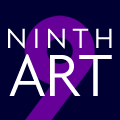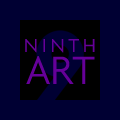>> Top Nine: O'Brien's Choice
>> Article 10: Arts From Their Elbows
More...

Comics are a visual medium.
I appreciate that this is a statement of the obvious, but it seems to be worth mentioning. Outside a small group of relative academics, comics critics - and I certainly include myself in this - have an unfortunate habit of not giving much attention to the art. The prevailing approach is very much story-centred.
There are various explanations for this. The conventional one is that it's much, much easier to write about the story than about the art. And that's certainly true. It's much easier to discuss in prose aspects of the writing as opposed to qualities of the art. For one thing, you can quote dialogue with ease, compared to the hassle involved in scanning and incorporating panels for discussion and the difficulty of describing artwork in a meaningful way.
Plus, in reviewing writing, you can import the critical vocabulary you were taught at school in English classes. You can draw on a wide range of fiction as a basis for discussing the stories. Broadly speaking, the principles of character development, plotting and so forth carry over relatively easily from other media. Most critics are much less familiar with the technical aspects of art, and even if they were, would struggle to discuss it in a way that made sense to most of their readers.
'The prevailing approach of critics is very much story-centred.' I've said for years that there's a huge gap in mainstream comics journalism for people who can write intelligently, accessibly and entertainingly about the art. After all, the artist accounts for most of what you see on the page. Actually, if you want to be technical, most of the ink on the page is the work of colourists - and they get even less attention than the pencillers. But the point remains that the art doesn't get the consideration it deserves.
But there's more to it than just the laziness of reviewers.
As a general rule, the primary credit for the creation of a comic tends to be attributed to the writer rather than the artist - not just by critics but by the audience. You'll rarely see refererences to Dave Gibbons' WATCHMEN, or Darick Robertson's TRANSMETROPOLITAN. If their names are mentioned, it's in conjunction with the writers. But the writers of those books are often given credit on their own.
This isn't something confined to prominent titles. To take the first trade paperback that comes to hand, THE WAITING PLACE was generally credited primarily to writer Sean McKeever rather than its artists Brendon and Brian Fraim. In fact, the introduction to the first trade paperback spends a page lauding the writer but doesn't mention the artists at all. Or POWERS, often described as a Brian Bendis comic, less commonly as a Michael Avon Oeming book - even though his art is one of the most distinctive things about the comic.
Yes, there are books which have been associated primarily or equally with their artists. There's books by writer/artists, but they don't really count for present purposes. There's the Lee/Kirby comics of the 1960s. Only an idiot could fail to notice that Kirby's contributions (and ideas) were among the most important aspects, both looking at the work in its own right and at the ways in which those books influenced later creators. There's all those godawful early Image books which existed primarily as a showcase for their artists, and the writing seemed to be an afterthought, if that - artist-driven books so blatant that not even the dumbest reader could fail to notice.
'The perception of writers as the prime movers isn't without foundation.' Compare the position in cinema, where the reverse applies. Respected films are almost invariably associated with either their directors or their stars. Most people couldn't tell you who wrote the screenplays for PSYCHO, SCHINDLER'S LIST or TAXI DRIVER. (Joseph Stefano from a novel by Robert Bloch, Steven Zaillian from a novel by Thomas Keneally, and Paul Schrader, respectively.) The writers tend to be sidelined in comparison.
I've never found auteur theory all that convincing. It ascribes a degree of creative impetus to the director which is not always justifiable, and can be overly dismissive of those films where the director was simply trying to shoot a very good script, simply because they don't fit the critic's paradigm of how films should be made. But the ascription of primacy to directors, at least in preference to writers, is hardly confined to auteurs. You can see it in every mainstream film magazine.
And it's easy to see why academic film critics have always been drawn to directors over writers. University film studies departments are naturally keen to investigate the areas of their chosen medium which are distinctive, rather than revisiting areas of narrative theory that have already been trodden into the ground over centuries of studying literature and theatre. While the director may not be the prime mover in the film as a whole, he is much more likely to be the person primarily responsible for those aspects of the film which are uniquely cinematic.
This reasoning does not seem to have caught on in comics circles, where we're all too keen to stress areas of commonality with other media and thereby save ourselves an awful lot of effort. It's not so long ago that wannabe artists were advised to read up on cinematography textbooks to learn about storytelling, for god's sake. Not that you can't learn from them, but film editing and panel layout are drastically different things.
When you consider the volume of critical material available on the specifics of cinema, it really does show up how shallow the pool of criticism in comics is by comparison. Cinema's not all that older than comics, after all.
But then again, the perception of writers as the prime movers in comics isn't entirely without foundation. To take those earlier examples, McKeever did create THE WAITING PLACE, after all. Warren Ellis has written publicly many times of his preference for full script in order to maintain control over the finished product. Alan Moore's scripts are notoriously exacting and detailed.
'There are artists who insist on drawing in very distinctive styles.' Moreover, while an "auteur" director might work from another person's scripts, the theory holds that he used that script as a vehicle for his own self-expression. The script might well be good in its own right, but the cinematic value of the film (or so it was argued) lay more in the manner in which the script was filmed than in the script itself. This was as opposed to directors who simply set out to film the script as well as they could.
It could well be argued that artists who work in collaboration with writers generally fall into the latter category. This is not in any way to disparage them. It's a category that includes plenty of excellent artists with spectacular storytelling ability and technical skill. But it's less easy to name artists who work in collaboration with writers and yet still seem to be the dominant creative force in their body of work. Artists who've wanted to move in that direction seem, like Frank Miller, to have taken up writing their own material.
There are some. Bill Sienkiewicz and Ashley Wood invariably dominate proceedings, often leaving battered and overpowered scripts bleeding in their wake. Mike Allred's work, whether alone or in collaboration with others, maintains a visual style with obvious retro overtones that continues to explore similar themes of genre and artificiality. There's Kirby and Ditko, obviously. Their status as co-writers blurs the issues, but the traditional Marvel working methods did provide considerable opportunities for artists to take the reins.
And yes, I suppose those god awful early Image books have to count, because whatever massive flaws they may have had, they were unquestionably artist-driven comics (something which, of course, ended up giving the very idea a bad name for a while).
Plus, there are the artists who insist on drawing in very distinctive and unusual styles guaranteed to distract attention from the plot, irrespective of whether there is any aesthetic or expressive point in doing so. The tail end of DOOM 2099, for example. Or any of those mid-nineties artists who insisted on drawing fill-in issues of superhero comics in a massively exaggerated manga-influenced style full of big-eyed females that could only be read as gratuitously alien and disjointed when it appeared halfway through a storyline otherwise drawn in a completely different style.
And every so often there have been horror stories of lunatic artists handing in artwork bearing no resemblance to the plot, which can only serve to discourage writers from giving up control. The end products of these collaborations are, I suppose, artist-driven, albeit that the artist has driven at high speed into a brick wall.
It's easy to understand in this context why the more highbrow comics critics often seem primarily interested in the work of writer-artists. It may or may not be the ideal way of producing comics, but it seems more likely to result in an artist-driven approach to storytelling than collaborative comics - and it's the artist-driven comics that you might expect to show up the possibilities of comics as a visual medium, rather than as just another vehicle for rendering stories.

This article is Ideological Freeware. The author grants permission for its reproduction and redistribution by private individuals on condition that the author and source of the article are clearly shown, no charge is made, and the whole article is reproduced intact, including this notice.


